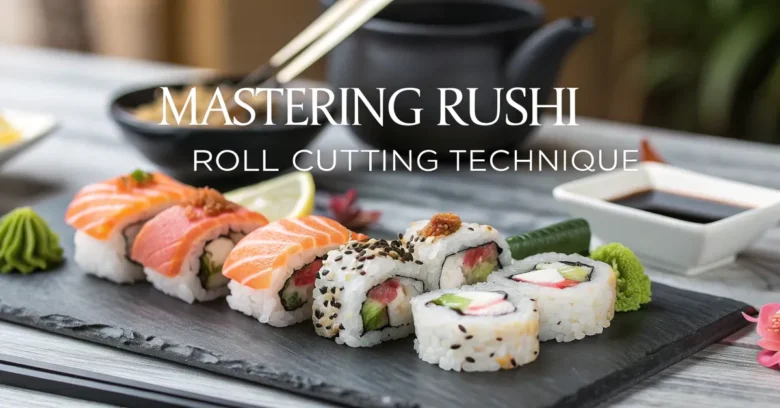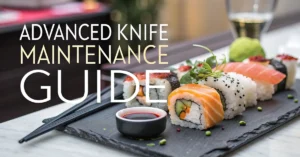Crafting sushi rolls at home can feel like a leap into the unknown. Those perfect, uniform slices you see at restaurants? They seem miles away. But don’t let that intimidate you. It’s more attainable than you think, and the key lies in mastering the art of the roll cutting.
This isn’t just about aesthetics, though a beautifully cut sushi roll is definitely a treat for the eyes. The right cut affects the texture, the way the flavors combine in each bite, and even how easily you can pick up the piece with your chopsticks. This guide will take you from novice to confident sushi chef, focusing on simple techniques and practical tips that will transform your homemade sushi experience.
We will go over the best practices to ensure a seamless cutting experience, including preparation, knife selection, and, of course, the cutting techniques themselves. So grab your sharpest knife, and let’s get started on perfecting your sushi roll cutting skills.
Essential Tools for Precise Roll Cutting
Before we dive into the techniques, let’s make sure you have the right tools. Having the correct equipment can significantly improve your results. Here’s a list of essentials:
- Sharp Knife: The most important tool. A dull knife will tear the roll, making a mess.
- Cutting Board: Provides a stable surface for cutting.
- Damp Cloth: Keeps the knife clean and prevents sticking.
- Water Basin: For rinsing the knife.
Knife Selection: The Key to Clean Cuts
A sharp knife is the most important tool for cutting sushi rolls. A dull blade will crush the roll, resulting in uneven slices and a messy presentation. Here’s what to look for:
- Type of Knife: A sushi knife (like a Yanagiba or Deba) is ideal, but a sharp chef’s knife or a slicing knife will also work well.
- Blade Material: High-carbon stainless steel is a good choice as it holds an edge well and is resistant to rust.
- Sharpness: A razor-sharp edge is crucial. If your knife isn’t sharp, consider getting it professionally sharpened or learning how to sharpen it yourself.
Preparing Your Cutting Surface
The cutting surface also plays a crucial role in achieving clean cuts. A stable, non-slip cutting board is essential.
- Type of Cutting Board: A wooden or plastic cutting board is suitable. Avoid glass or ceramic, as they can dull your knife quickly.
- Stability: Place a damp cloth under the cutting board to prevent it from slipping. This adds stability and makes the cutting process safer.
- Cleanliness: Ensure the cutting board is clean and dry before you start.
Knife Maintenance: Keeping Your Blade Ready
Maintaining your knife properly is essential for consistent, clean cuts. Here’s how to keep your knife in top condition:
- Cleaning: Rinse the knife with water after each cut. Wipe the blade with a damp cloth to remove any rice or filling that sticks to it.
- Drying: Dry the knife thoroughly after cleaning to prevent rust.
- Storage: Store your knife in a knife block or sheath to protect the blade.
- Sharpening: Sharpen your knife regularly to maintain its edge. Use a whetstone or a knife sharpener, or take it to a professional.
Preparing the Roll for Cutting
Before you even think about slicing, the sushi roll needs to be properly prepared. This step is crucial for preventing the roll from falling apart during the cutting process. Here’s how to do it:
- Firmness: Ensure that the sushi roll is firm and well-compacted. A loose roll will be difficult to cut cleanly.
- Resting Time: Allow the roll to rest for a few minutes after rolling. This helps the ingredients settle and the nori to soften slightly, making it easier to cut.
- Moisture Balance: The rice should be moist enough to stick together but not so wet that it becomes mushy. The right balance is key to a well-formed roll.
Achieving the Ideal Roll Firmness
A firm sushi roll is essential for achieving clean, even cuts. Here are some tips to ensure your roll is perfectly firm:
- Even Distribution: Spread the rice evenly over the nori, leaving a small border at the top edge.
- Gentle Pressure: When rolling, use gentle but firm pressure to compact the ingredients. Avoid squeezing too hard, which can damage the ingredients.
- Tight Seal: Ensure that the roll is tightly sealed at the seam. This prevents the roll from unraveling when you cut it.
The Importance of Resting Time
Allowing the sushi roll to rest before cutting is a crucial step that many home cooks overlook. This resting period allows the ingredients to settle and the nori to soften slightly, making the roll easier to cut without tearing or squishing.
- Resting Period: Let the roll rest for at least 5-10 minutes before cutting.
- Room Temperature: Keep the roll at room temperature during the resting period. Avoid refrigerating it, as cold rice can become hard and difficult to cut.
- Nori Softening: The resting period allows the nori (seaweed) to absorb some moisture from the rice, making it more pliable and less likely to crack when cut.
Perfecting the Moisture Content
The moisture content of the rice is crucial for creating a sushi roll that holds together well and cuts cleanly.
- Rice Preparation: Use the correct ratio of water to rice when cooking. Too much water will result in mushy rice, while too little will make it dry and crumbly.
- Sushi Vinegar: Properly season the rice with sushi vinegar. This not only adds flavor but also helps to bind the rice grains together.
- Cooling: Allow the rice to cool slightly before rolling. Warm rice is easier to work with, but it should not be too hot, as this can make the nori soggy.
Mastering the Cutting Techniques
Now that you have the right tools and a well-prepared sushi roll, it’s time to focus on the cutting techniques. The goal is to achieve clean, even slices without squishing or tearing the roll.
- The Initial Cut: Start with a clean, decisive cut in the center of the roll.
- Consistent Pressure: Use consistent pressure throughout the cut to ensure even slices.
- Cleaning the Knife: Clean your knife after each cut to prevent rice and fillings from sticking to the blade.
- Slice Thickness: Aim for uniform slice thickness.
The Push-and-Pull Method
The push-and-pull method is one of the most effective techniques for cutting sushi rolls cleanly. It involves using a gentle sawing motion rather than applying direct downward pressure.
- Positioning: Place the sushi roll on the cutting board with the seam facing down.
- Starting the Cut: Position the knife at the center of the roll.
- Sawing Motion: Use a gentle sawing motion, moving the knife back and forth while applying slight downward pressure.
- Consistent Speed: Maintain a consistent speed and pressure to create even slices.
- Cleaning: Clean the knife after each cut to prevent sticking.
The Single-Stroke Method
The single-stroke method involves cutting through the sushi roll in one smooth, continuous motion. This technique requires a very sharp knife and a steady hand.
- Positioning: Place the sushi roll on the cutting board with the seam facing down.
- Starting the Cut: Position the knife at the center of the roll.
- Smooth Motion: Apply firm, even pressure and cut through the roll in one smooth motion.
- Avoid Sawing: Avoid sawing back and forth, as this can tear the roll.
- Cleaning: Clean the knife after each cut to prevent sticking.
The Lift-and-Wipe Technique
The lift-and-wipe technique is essential for preventing rice and fillings from sticking to the knife. It involves lifting the knife after each cut and wiping the blade clean with a damp cloth.
- Cutting: Cut through the sushi roll using either the push-and-pull or single-stroke method.
- Lifting: After each cut, lift the knife straight up from the cutting board.
- Wiping: Wipe the blade clean with a damp cloth, removing any rice or filling that has stuck to it.
- Repeat: Repeat this process for each slice.
Tips for Achieving Uniformity in Slices
Achieving uniform slices is key to a professional-looking sushi presentation. Here are some tips to help you achieve consistent slice thickness:
- Visual Guide: Use your fingers as a visual guide for slice thickness. Aim for slices that are about the width of your index finger.
- Consistent Pressure: Maintain consistent pressure throughout the cut to ensure even slices.
- Practice: Practice makes perfect. The more you cut sushi rolls, the better you will become at judging the right thickness.
- Marking: If you are having trouble with consistency, you can lightly mark the roll with a knife before cutting to create a visual guide.
Troubleshooting Common Cutting Issues
Even with the right tools and techniques, you may encounter some common issues when cutting sushi rolls. Here are some tips for troubleshooting:
- Roll Falls Apart: Ensure the roll is firm and well-compacted. Use the correct rice-to-water ratio and season the rice properly with sushi vinegar.
- Uneven Slices: Practice consistent pressure and use a visual guide for slice thickness.
- Knife Sticks: Clean the knife after each cut and keep a damp cloth handy.
- Torn Nori: Ensure the nori is not too dry. Allow the roll to rest for a few minutes before cutting to allow the nori to soften slightly.
Preventing the Roll from Falling Apart
One of the most frustrating issues when cutting sushi rolls is having the roll fall apart. Here’s how to prevent this:
- Firmness: Ensure the roll is firm and well-compacted. Use gentle but firm pressure when rolling.
- Rice Quality: Use high-quality sushi rice that is sticky enough to hold together well.
- Sealing: Ensure that the roll is tightly sealed at the seam. This prevents the roll from unraveling when you cut it.
- Resting: Allow the roll to rest for at least 5-10 minutes before cutting to allow the ingredients to settle.
Achieving Even Slices
Uneven slices can detract from the presentation of your sushi rolls. Here’s how to achieve even slices:
- Consistent Pressure: Maintain consistent pressure throughout the cut. Avoid pressing too hard or too softly.
- Visual Guide: Use your fingers as a visual guide for slice thickness. Aim for slices that are about the width of your index finger.
- Practice: Practice makes perfect. The more you cut sushi rolls, the better you will become at judging the right thickness.
- Marking: If you are having trouble with consistency, you can lightly mark the roll with a knife before cutting to create a visual guide.
Dealing with a Sticky Knife
A sticky knife can make cutting sushi rolls a messy and frustrating experience. Here’s how to deal with it:
- Cleaning: Clean the knife after each cut to prevent rice and fillings from sticking to the blade.
- Damp Cloth: Keep a damp cloth handy and wipe the blade frequently.
- Water Basin: Keep a water basin and dip the knife often.
- Non-Stick Spray: Consider using a non-stick cooking spray on the blade to prevent sticking. Be sure to wash the knife thoroughly after use.
Avoiding Torn Nori
Torn nori can be a common issue, especially if the nori is too dry or brittle. Here’s how to avoid it:
- Nori Quality: Use high-quality nori that is pliable and not too brittle.
- Resting Time: Allow the roll to rest for a few minutes before cutting to allow the nori to soften slightly.
- Moisture: If the nori is too dry, lightly dampen it with a mist of water before rolling.
- Sharp Knife: Use a very sharp knife to cut through the nori cleanly.
Adding a Professional Touch to Your Sushi
Once you’ve mastered the basic cutting techniques, you can start to add some professional touches to your sushi presentation. These small details can make a big difference in the overall appeal of your homemade sushi.
- Arranging the Slices: Arrange the slices neatly on a plate.
- Garnishes: Add garnishes like ginger, wasabi, and edible flowers.
- Sauces: Serve with complementary sauces like soy sauce, ponzu sauce, or spicy mayo.
Arranging the Slices for Visual Appeal
The way you arrange the sushi slices on the plate can significantly impact the visual appeal of your presentation.
- Neat Rows: Arrange the slices in neat, even rows.
- Overlapping: Consider slightly overlapping the slices to create a visually appealing effect.
- Color Contrast: Arrange the slices to showcase the colors and textures of the ingredients.
- Symmetry: Aim for symmetry in your arrangement.
Garnishing for Flavor and Presentation
Garnishes not only add flavor but also enhance the visual appeal of your sushi presentation.
- Ginger: Serve with pickled ginger (gari) to cleanse the palate between bites.
- Wasabi: Add a small amount of wasabi for a spicy kick.
- Edible Flowers: Use edible flowers for a pop of color and elegance.
- Green Onions: Sprinkle with chopped green onions for a fresh, savory flavor.
- Sesame Seeds: Sprinkle with sesame seeds for added texture and flavor.
Complementary Sauces for the Perfect Bite
Serving your sushi with complementary sauces can elevate the flavor profile and provide the perfect finishing touch.
- Soy Sauce: Serve with high-quality soy sauce for dipping.
- Ponzu Sauce: Offer ponzu sauce for a tangy, citrusy alternative.
- Spicy Mayo: Provide spicy mayo for those who enjoy a creamy, spicy kick.
- Eel Sauce: Drizzle with eel sauce (unagi sauce) for a sweet and savory flavor.
- Tamari: Offer tamari for a gluten-free alternative to soy sauce.
Perfect Practice Makes Perfect
Perfecting your sushi roll cutting technique takes time and practice. Don’t get discouraged if your first few attempts aren’t perfect. Keep practicing, and you’ll gradually improve your skills.
Repeat and Refine: Honing Your Skills
Consistent practice is the key to improving your sushi roll cutting technique.
- Regular Practice: Set aside time to practice cutting sushi rolls regularly.
- Experiment: Experiment with different techniques and find what works best for you.
- Record Yourself: Record yourself cutting sushi rolls and review the footage to identify areas for improvement.
- Seek Feedback: Ask for feedback from friends or family members who have experience with sushi making.
Embrace Imperfection: Learning from Mistakes
Mistakes are a natural part of the learning process. Don’t be afraid to make mistakes and learn from them.
- Analyze Mistakes: Take the time to analyze your mistakes and identify what went wrong.
- Adjust Technique: Adjust your technique based on what you learn from your mistakes.
- Stay Positive: Stay positive and don’t get discouraged. Every mistake is an opportunity to learn and improve.
- Celebrate Progress: Celebrate your progress and acknowledge how far you’ve come.
Persistence and Patience: The Path to Mastery
Mastering sushi roll cutting requires persistence and patience.
- Set Realistic Goals: Set realistic goals for yourself and don’t expect to become a master overnight.
- Be Patient: Be patient with yourself and allow yourself time to learn and improve.
- Stay Committed: Stay committed to your goal and don’t give up easily.
- Enjoy the Process: Enjoy the process of learning and creating delicious sushi rolls.
What’s the Best Way to Slice Sushi Rolls?
Mastering the sushi roll cutting technique is an art that combines the right tools, careful preparation, and consistent practice. By focusing on a sharp knife, achieving the ideal roll firmness, and using precise cutting techniques, you can create beautifully sliced sushi rolls that are both visually appealing and delicious.
So, embrace the process, keep practicing, and enjoy the journey of becoming a confident sushi chef in your own kitchen.



